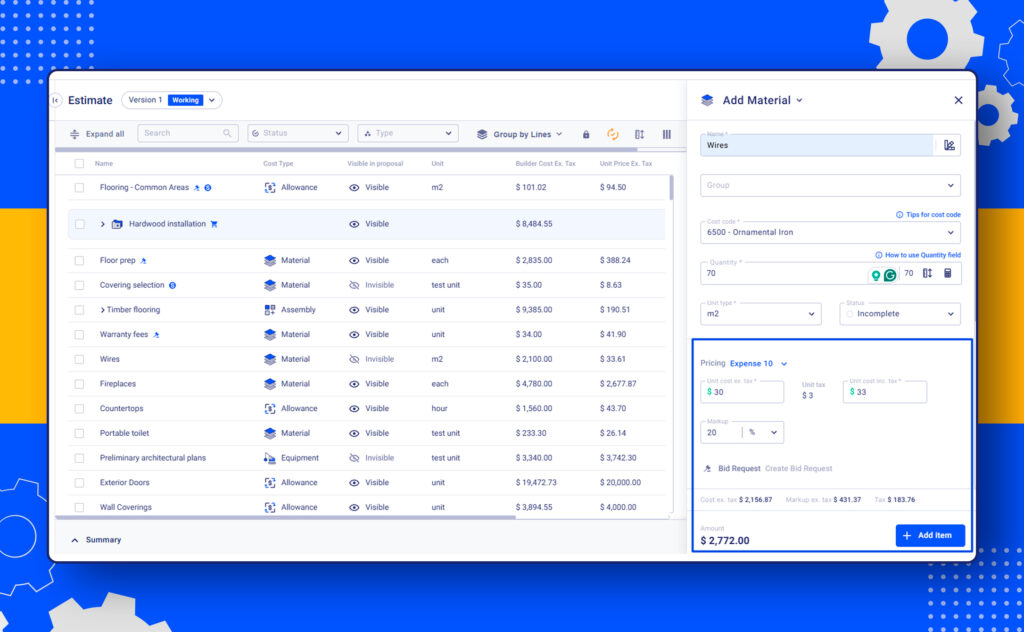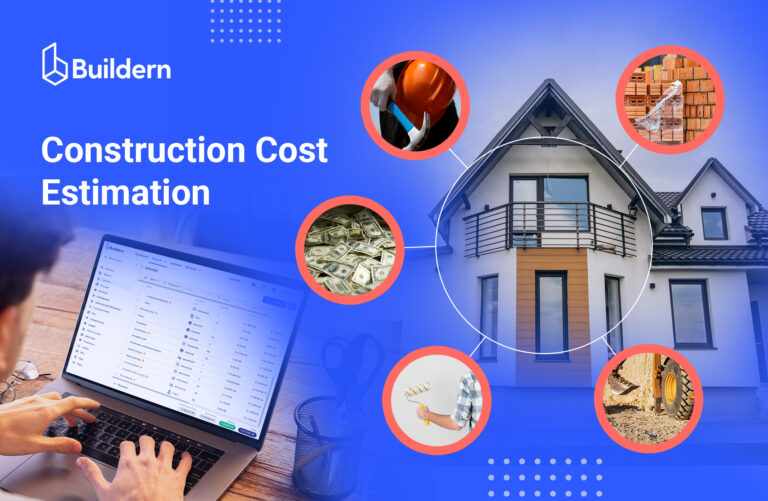General Contractor Markup: Everything You Need to Know

Did you know that the average general contractor markup on labour is 25% and higher, and on materials, it can be as high as 50%?
What does this imply for your business as a builder?
Considering these average markup percentages, it’s essential to ask yourself: Are you charging enough to impact your profitability positively, or are you potentially being underpaid?
The truth I’ve learned through the years is that your pricing strategy significantly influences your construction financial management strategy and financial health. If your markup on labour or materials falls short of the industry averages, you might undervalue your services and undermine your profit potential.
Table of Contents
- What Is General Contractor Markup?
- The Average Markup for a Builder
- Markup vs. Margin
- Calculating Your Markup
- Use Construction Markup with Advanced Technology
- General Contractor Markup Types to Consider
- Should the Clients Know About General Contractor % Markup?
TL;DR
- Markup refers to adding a percentage or fixed amount to the direct construction costs to cover indirect costs, overhead, and profit.
- Markup vs Profit Margin: Markup is added to the cost, whereas margin is subtracted from revenue.
- Defining general contractor markup can seem simple, but the process requires precise calculations and reliable construction software to ensure your business’s profitability.

What Is General Contractor Markup?
Markup is best defined as an additional percentage or dollar amount that general contractors add to the total cost of a project. The markup includes not only labour and materials costs but also soft costs like insurance, permits, office expenses, etc.
Balancing your markup rates as a general contractor is a delicate act. If your rates are excessively high, you may be disqualified from potential projects due to uncompetitive pricing. Pricing your services too low leaves you with minimal leeway for unforeseen expenses, increasing the risk of financial loss.
Therefore, it’s crucial to establish a pricing strategy that caters to your business needs while remaining appealing to your clients.
The Average Markup for a Builder
There is no fixed answer to this question. Markup rates can vary significantly depending on the type of project, location, competition, and other factors. However, industry experts suggest that a general contractor should mark up labour costs by around 25% and more, and material costs should see a markup of approximately 30% to 50%.
The Construction Financial Management Association reveals that builders typically enjoy an average pre-tax net profit ranging from 1.4 to 2.4 percent. Conversely, subcontractors see a slightly higher average pre-tax net profit, falling between 2.2 to 3.5 percent.
However, it’s important to note that these figures, while they might seem decent, barely cover the inherent risks associated with the construction industry.
This slim profit margin is barely sufficient for many contractors to remain viable and sustain their operations. Thus, maintaining an appropriate markup on labour and materials is not just recommended but is vital for survival in the competitive environment of this sector.
Markup vs. Margin
Yes, the terms are often interchangeable, but they are two different concepts.
Markup is the percentage added to a product or service’s cost price to reach the final price offered to clients. In contrast, margin is the difference between the final price of a product or service and its cost price.
In simpler terms, markup is added to the cost, whereas margin is subtracted from revenue.
For example, if you calculate your labour costs for a project at $10,000 and apply a 20% markup rate, your total charge to the client will be $12,000 ($10,000 + $2,000 = $12,000).
In this case, your margin will be $2,000 ($12,000 – $10,000 = $2,000), which is 16.6% of the final price. See the calculations below with the P denoting our margin percentage:
12,000 * P / 100 = 2,000
P = 2,000 / 120
P = 16.6%
Calculating Your Markup
The process may seem tricky for some contractors.
But not you!
You can develop a comprehensive and profitable pricing strategy with the right approach.
First thing is to study this formula:

The idea is to determine a fair and sustainable gross profit margin for your business based on the market research in your area, project type, and size.
Then, you can allocate overhead expenses as a percentage of the job cost (including labour and material costs) to arrive at an accurate markup rate.
To better illustrate the relationship between markup and profit, consider this basic table that represents the necessary markup on costs to secure the profit you need to maintain daily operations:
- For a 15% profit, your markup on costs should be 17.65%.
- For a 25% profit, your markup on costs should be 33.33%.
- For a 35% profit, your markup on costs should be 53.85%.
- For a 40% profit, your markup should be 66.67%.
Now, let’s apply this in a real-world context.
Suppose your labour costs for a project amount to $10,000, and you decide to apply a 17.65% markup rate for a 15% profit. Your total charge to the client will be $11,765 ($10,000 + $1,765 = $11,765).
In this scenario, your profit margin will be $1,765 ($11,765 – $10,000 = $1,765), roughly 15% of the final price.
To make things even simpler for you, here are some steps to help you calculate your markup:
Identify all material costs associated with the project.
This includes but isn’t limited to:
- Material costs, including specialized equipment
- Labour costs, including wages, salaries, payroll taxes, and benefits
- Overhead costs, like office expenses, rent/mortgage payments, insurance premiums, etc.
- Quotes from subcontractors
Also, consider having a contingency plan for unexpected expenses like weather delays, additional materials or labour needs, etc.
Use Construction Markup with Advanced Technology
Calculating and adding the general contractor % markup to each item in the estimate can be a daunting task. It requires painstaking attention to detail, ensuring that each material, labour, and overhead cost is accurately accounted for and appropriately marked up.
This process can be time-consuming and prone to errors, especially when managing multiple projects simultaneously. Therefore, I offer you the opportunity to explore Buildern’s advanced solutions!

With construction management software, you can create accurate estimates, apply markup rates automatically, track project expenses, and generate WIP reports in a fraction of the time it would take to do it manually.
Buildern is designed to help general contractors work smarter while simplifying the markup application process and allowing you to focus on what you do best – constructing great buildings.
Benefits of Using Buildern
- Customizable Markup Rates: Tailor markup rates to specific items, ensuring your estimates are competitive and profitable.
- Well-structured Estimates: Buildern gives a clear and comprehensive breakdown of costs, enhancing client transparency and trust.
- Time-Efficient: Spend less time crunching numbers and more time on-site, overseeing your projects.
General Contractor Markup Types to Consider
Everything looks nice and pretty until you realise there may be several construction markup types (each with its own considerations) to choose from:
Cost-Plus Pricing
In this pricing model, contractors bill their clients for the actual cost of labour and materials plus an added percentage that covers overhead expenses and profit. It’s a transparent way to price projects, as customers know exactly what they are paying. However, it may not always be profitable for the contractor if costs exceed estimates or clients negotiate too hard on percentages.
In that case, builders should have a backup plan, like allowances or contingencies, to ensure they don’t lose money on projects.
Allowance Markups
Most contractors find it safe to apply a flat markup to all materials, regardless of cost. However, it can be an expensive and inaccurate pricing strategy as it provides no way to adjust markup depending on the actual costs of the material.
With allowance markups, contractors should always consider whether the additional cost requires only administrative work or additional installation and supervision. For example, if the material costs $100 per unit and requires only minor handling to install, you can consider a flat markup of 30% (or $130) to cover all overhead expenses.
In contrast, if the material costs thousands of dollars and needs specialized installation or supervision, a simple markup percentage won’t suffice. In such cases, you may apply different markups based on the material’s cost and complexity, ensuring you cover all costs while still making a profit.
Fixed Price Markup
In this pricing model, contractors agree with clients on a fixed price for the entire project, regardless of actual costs. The advantage is knowing exactly how much you will make before starting work. However, this pricing model may not be suitable if your cost estimates are inaccurate or if unforeseen expenses arise.
You can also use hybrid markups, which combine cost-plus and fixed-price markup models to provide a more accurate pricing strategy for your business. It allows you to charge clients the actual costs for labour and materials, plus a fixed amount that covers overhead expenses and profit.
Should the Clients Know About General Contractor % Markup?
Ideally, your markup cannot and should not be negotiable.
However, developing trust and co-dependency is vital for any contractor-client relationship. Hence, good communication and transparency are essential to maintain a healthy business.
Yet, some clients don’t want to know the markup percentage for their projects, and contractors usually don’t share this information unless required.
However, contractors should be transparent about their pricing methods if a client asks. Clients may also wish to negotiate on margins or ask for cost breakdowns, making it essential for contractors to understand clearly how they calculate markups and margins.
Final Thoughts
So, what’s your answer to my main question?
Are you charging enough to impact your profitability positively, or are you potentially being underpaid?
Having navigated through this comprehensive guide, you should now be equipped to answer this critical question confidently.
With a firm grasp of the concepts discussed and advanced construction software, you can now accurately determine if your current pricing strategy is optimizing your revenue stream or if you’re underselling your services.

What Is a Good Markup Percentage?
A normal builder markup depends on overhead structure, business size, and risk exposure. Many builders apply a markup between 10 and 30 percent to cover operating expenses and ensure a stable profit. High-risk or highly specialized work may require a higher markup to compensate for warranty exposure, schedule uncertainty, or market volatility.
How Does Markup Differ From Margin?
Markup is the percentage added on top of direct job costs to cover overhead and profit. Margin is the profit percentage based on the final selling price. Builders often confuse these two, which can lead to underpricing. A precise estimating workflow helps keep both calculations aligned with company targets.
Does General Contractor Markup Change Depending on Project Type?
Yes. Remodels, custom builds, and commercial jobs carry different risks, overhead requirements, and labor productivity rates. Builders typically adjust markup to reflect complexity, number of stakeholders, and the amount of coordination needed. Tracking historical job costing data helps establish the right markup range for each project type.


